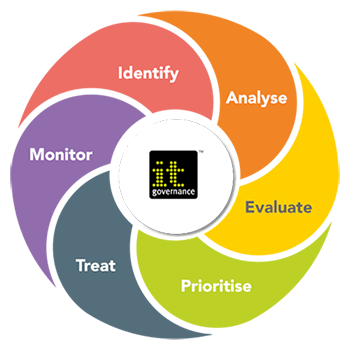Risk management in IT is a systematic approach to identify, analyze, evaluate, prioritize, treat, and monitor risks associated with information technology.

Identify
The first step in risk management is to identify potential risks. This involves identifying and documenting risks that could impact IT systems, assets, or operations. It can be achieved through techniques such as risk assessments, vulnerability scanning, threat intelligence, and input from stakeholders. The goal is to comprehensively identify risks that may arise from internal or external sources, including technological vulnerabilities, human errors, malicious activities, natural disasters, or regulatory changes.
Analyze
After identifying risks, the next step is to analyze them. This involves a detailed examination of each risk to understand its nature, potential causes, potential impacts, and potential consequences. It may require gathering relevant information and data to facilitate an accurate analysis. By analyzing risks, organizations can determine the likelihood of occurrence and the potential magnitude of their impact on the organization’s objectives, resources, reputation, compliance obligations, and stakeholder interests.
Evaluate
Following risk analysis, the next step is to evaluate the risks. Risk evaluation involves assessing the significance of each identified risk based on its potential impact and likelihood. This process helps prioritize risks for further attention and resource allocation. Organizations may use risk evaluation techniques such as risk matrices, risk scoring, or qualitative assessments to assign risk levels and determine the overall severity of each risk. By evaluating risks, organizations can gain insights into their potential impact on business operations and make informed decisions regarding risk management strategies.
Prioritize
Once risks are evaluated, they need to be prioritized. Prioritization involves ranking the risks based on their level of importance or urgency. This allows organizations to focus their resources and efforts on managing the most critical risks first. Prioritization can be based on factors such as the potential impact on business objectives, the likelihood of occurrence, regulatory requirements, stakeholder expectations, legal obligations, financial considerations, or other organizational priorities. By prioritizing risks, organizations can ensure that risk management efforts are effectively directed towards addressing the most significant risks.
Treat
Risk treatment is the process of developing and implementing risk management measures to address identified risks. It involves selecting and implementing appropriate strategies to reduce, mitigate, transfer, or accept the risks. Risk treatment measures can include implementing security controls, developing incident response plans, conducting staff training and awareness programs, establishing backup and recovery mechanisms, enhancing physical security, or obtaining insurance coverage. The goal of risk treatment is to effectively reduce the likelihood and impact of risks to an acceptable level in alignment with the organization’s risk appetite and objectives.
Monitor
Risk management is an ongoing process that requires continuous monitoring. Monitoring involves tracking and reviewing the effectiveness of risk management measures that have been implemented. It enables organizations to detect changes in the risk landscape, identify emerging risks, and assess the performance of risk controls. Regular monitoring activities can include periodic risk assessments, security audits, vulnerability scanning, incident reporting and analysis, key risk indicator tracking, compliance reviews, and staying informed about industry trends and regulatory updates. By monitoring risks, organizations can ensure that risk management strategies remain relevant and effective in addressing evolving threats and vulnerabilities.
Effective risk management in IT involves a comprehensive approach to identify, analyze, evaluate, prioritize, treat, and monitor risks. By following these steps, organizations can proactively manage potential vulnerabilities, protect critical assets, maintain business continuity, comply with regulatory requirements, enhance security and privacy, and build resilience against cyber threats and operational disruptions. Regular assessment and reassessment of risks, along with continuous monitoring and improvement, are key to maintaining an effective risk management program in the rapidly evolving IT landscape.
